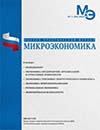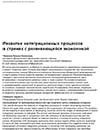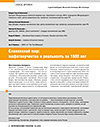Development of integration processes in countries with a emerging economy
The article discusses the features of integration processes in modern developing countries. Shows the goals that pursue nation-states in the organization of integration unions. The position of the majority of associations of developing countries within the stages of development of world integration processes is indicated. The current and forecast dynamics of economic indicators of developing countries in comparison with the indicators of developed countries and the world as a whole is analyzed. Based on relevant statistics, a number of existing integration unions of countries with developing economies from various regions of the world are examined in terms of their composition and basic socio-economic parameters. The negative trends in the development of modern integration processes in countries with developing economies are investigated and the reasons hindering the effectiveness of their integration are identified.





